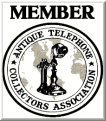|




| There are a lot of images on
these pages, please be patient when downloading. |

|
I invite you to click on the small
picture to see a larger version.
These photographs are not to scale
|
Western Electric 132B Dial Face |
|
Pictured are two 132B dial
faces and both are stamped 132B on the back. The one on the
left is what is normally found. The one on the right is
noticeable different. Note the Z above the operator at the
"0" location. The Z is found on later 149 and 150 dial
faces, but not normally on 132 faces. |
|
Western Electric #2 AG Dial |
|
c. pre 1929 - Extremely rare.
Interesting configuration of letters. Pictured here is a
#2 dial with a 132G face. The AG configuration is the rarest
of WE#2 dials. I am unsure of its application, although
there is speculation it was provided to independently owned
telephone companies. It was discontinued in 1929. |
|
Western Electric #2CB Dial |
|
c. 1929 - Pictured above is a #2
dial with a standard 132B face. Fingerstop reads 2CB. It's
application was intended for use with company test man hand
sets. It differs from the standard #2AB dial only that it
was adjusted to return at a somewhat higher speed and
carried the identifying CB fingerstop. This one is mint and
dated 1929. (I especially like the number card with
Keystone). I have an additional #2
dial (would have been a CB) removed from a fresh find test
set with a fingerstop having no markings (blank) so possibly
at some time, either early or later they did not equip all
with stamped stops. Again, it's Western Electric...often
nothing was set in stone! |
|
Western Electric #2AH Dial |
| c. pre 1929 - Extremely Rare. Pictured here is a
#2 dial with a H type face. The AH configuration is another
one of the rarer WE#2 dials, the face being totally void of
any markings. It was used on #50 coin collectors before
1928. Unlike the #2AC dial (pictured earlier on the #51 Desk
Stand) the AH dial was used in conjunction with a 56A dial
adapter. The adapter was somewhat different than the daisy
ring we usually see. I have never seen one in person, but
from what I have been told, it was a stamped-steel adapter
into which a porcelain type "daisy wheel" was fastened. The
faceplate had 3 threaded parts that extended thru the
adapter fastened by 3 acorn cap nuts.
|
|
Western Electric #2 EA Dial |
| c. 1927ish - Pictured here are a pair of #2EA Dials.
Production on this dial began about the same time as the
#2GB and, other than the numbers only dial face, is
identical in appearance to the #2GB dial shown on the
Western Electric A1 desk set (see
page 4). The #2EA was designed for use on switchman's
desks, trouble desks, and local test desks of manual
offices, for connecting with machine switching offices. Like
the #2GB, the first #2EA's were factory altered #2A dials
with the "W" or fifth terminal added and the W stamped into
the back of the case. Pictured are two style EA dials with
the only difference being the finger stops. The one on the
right is standard, whereas the one on the left, is equipped
with a "sloping face finger stop" as identified per Bell
System Practices. I understand the design was for comfort of
the operator. I have often seen later dials with inside
mounted stops having the "sloping face" style, but this is
the fist example I have run across in an earlier outside
mount stop. This dial was subsequently replaced with a H
style dial. |
|
Western Electric #4 B Dial Face |
|
Pictured
here is a #4 dial face with B (metro) designation. Normally,
metro dial faces produced after the #132B had the black
letter "Z" above the "operator". This one is missing the
"Z". This and the dial face
above show nothing was "set in stone" with Western Electric. |
|
Western Electric Celluloid Dial Face |
|
c.
1933-34 - This dial plate (face) is
made of thin celluloid. It was the prototype/predecessor to
the #149 Celluloid over metal type. |
| c. unk - This specific Sani-Dial was produced for use on
Western Electric dials. They were available in gold look or
chrome finish, this one being chrome. Supposedly, it had a
brighter look making it easier to use the dial and could be
easily cleaned in areas where peoples fingers touched. |
|
Western Electric Plastic Dial Face |
|
c. 1950's?
- Here is a very unusual and
rare Western Electric PLASTIC dial face. This dial face was
produced for a very short time (date unknown although most
likely the 1950's). This one has no cracks or chips although
some discoloration due to age. Although I do not collect
phones for this period, I enjoy rare dials or dial parts
from any period. |
|
Western Electric 684A Ringer Box/Subset |
|
c. 1936 - Subset dated 1936. I
normally do not display this type of item, but this is a
more rare and unusual example. This subset is equipped
with chimes rather than the normally seen bells. |

|
